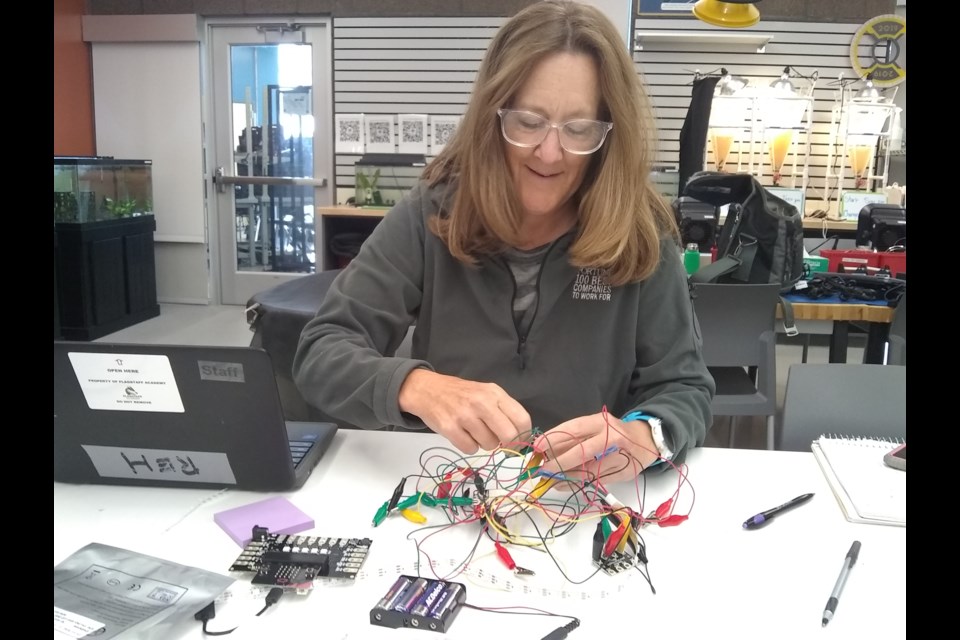Six teachers from St. Vrain Valley School District returned to the classroom this week, once again becoming students themselves in order to learn leading-edge technology from University of Colorado Boulder education researchers.
The three-day course, which ran Monday through Wednesday at the district’s Innovation Center, marks the start of SVVSD’s participation in the $20 million iSAT project funded by the National Science Foundation and based locally at the University of Colorado Boulder's Institute of Cognitive Science. iSAT stands for Institute for Student-AI Teaming, where “AI” refers to artificial intelligence and “teaming” refers to collaborative small group interactive learning.
CU Boulder is one of nine universities around the nation participating in the five-year project, which launched in 2020. Denver Public Schools is also participating in affiliation with CU Boulder. Colorado State University is another coalition university.
According to the project website, iSAT involves a consortium of universities working alongside public school districts, private companies and community leaders in order to “transform education.”
“The whole project is about promoting collaboration between students, especially in small groups. We view learning as a socio-cognitive endeavor where students learn by engaging with their peers,” said co-instructor Jeffrey Bush, research associate at ICS.
The curriculum offered at SVVSD this week was developed at the ICS-based SchoolWide Labs, where Bush and co-instructor, Quentin Biddy, research professor at ICS, serve as researchers and Teacher Learning Facilitators.
According to Bush, learning at its best is about much more than just assimilating information mentally, and the curriculum reflects that.
“Students watch a video about an artist that created a sensor system using wind chimes to collect data about air pollution, to make that more accessible to the public. Then we have this data sensor system showing us data about our classroom,” Biddy said.
“If you push a button it will measure humidity levels. You can also measure temperature, air pressure, carbon dioxide levels and VOCs (volatile organic compounds),” he said. Those measurements all come from a single environmental sensor.
Teachers built their own data sensor hubs, known as DaSH, during the course. A sound sensor and a soil moisture level sensor are also available. (All three sensors are made by Niwot-based SparkFun Electronics.)
“They’re given some guidelines to include at least two sensors, lights, and sound, and make it interactive, so kids can actually see it (the DaSH) change in response to things they’re doing,” Biddy said.
Once students are familiar with the sensors, they’ll develop data-collection projects of their own while working in small groups.
“How do I use this for my community? It’s not just ‘What did this one scholar say that I need to learn?’ With the sensor system, students think of things in their community that are relevant to their lives,” Bush said.
“Students are learning and developing their own understanding of the topic. Instead of that just happening in their own minds – it’s happening in the interactions that they have with their peers, with their teachers, and with the tools that they use in the classroom,” he said.
Bush and Biddy are collecting data on the teaching-learning process every step of the way, in order to better understand the learning needs of both teachers and their young students. Bush said that he and Biddy hope to be there in the classroom as each teacher implements the two-week sensor immersion unit.
Participating teachers signed consent forms for video and audio recording of this week’s course, which will then be analyzed in order to inform future offerings.
“We look at what types of things teachers are needing, how can we better support these teachers in using this curriculum effectively?” Bush said.
Data will also be collected in the classrooms as students work in small groups, which will be used to inform development of an artificial intelligence agent to facilitate small group learning ‒ a collaboration between SchoolWide Labs and the AI Institute for Student-AI Teaming.
“Supporting (peer learning) in a classroom can be challenging for teachers to implement well in small groups – they can’t be in multiple places at the same time,” Bush said.
“We’re collecting audio and video data where student identity is not tracked. We’re trying to understand how middle school students talk to one another about computer science and about STEM (science, technology, engineering and math) during small group learning,” he said.
Mai Vu, computer science teacher at Altona Middle School, said that she thought the course was excellent.
“All students should have collaborative learning. All students should feel empowered. We’re all good at something. That’s really what school is about – learning from other students,” Vu said.
“This is cutting-edge technology that the kids are getting exposed to, but we’re doing it thoughtfully, in how we’re deploying it, and why we’re deploying it. And that’s what gives our students a competitive edge in the future marketplace,” she said.
Five other schools and teachers participated in this week’s course, which was offered to all SVVSD middle school technology/STEM teachers and science teachers, said Axel Reitzig, coordinator of innovation at SVVSD’s Innovation Center.
- Flagstaff Academy, Terri Reh, Middle School Robotics/Computer Science Teacher
- Westview Middle School, Tami Root, Integrated Science Educator
- Soaring Heights K-8, Chris Schmitz, Middle School Computer Science/Technology Teacher
- Coal Ridge Middle School, Crystal Ulander, Middle School Computer Science/Technology Teacher
- SVVSD Innovation Center, Nate Wilcox, Robotics Program Manager
Six follow-up trainings are planned at SVVSD for the coming school year, three in the fall semester and three in the spring.
“The hope is that more teachers join this professional learning community, and we’ll support them as they implement this curriculum. We’ll also be co-designing with teachers to expand this curriculum, we work together with them in this process,” Biddy said.
Updates: The name of Flagstaff Academy was updated. Institute of Cognitive Science was added as housing iSAT at CU Boulder. Quentin Biddy's research professor title was added.



